- Submissions

Full Text
Aspects in Mining & Mineral Science
Volyn Pegmatite: Unusual Hydrocarbon-Bearing Fluid Inclusions in Pegmatite Quartz
Rainer Thomas1* and Dmytro K Voznyak2
1Im Waldwinkel 8, D-14662 Friesack, Germany
2M P Semenenko Institute of Geochemistry, Mineralogy and Ore Formation of the NAS of Ukraine, Ukraine
*Corresponding author:Rainer Thomas, Im Waldwinkel 8, D-14662 Friesack, Germany
Submission: December 13, 2023: Published: December 22, 2023

ISSN 2578-0255Volume12 Issue2
Abstract
This paper shows that pegmatite formation starts with an input of supercritical fluids, visible by nanodiamonds, from the mantle into the granites, which lie more in the crustal regions. The Volyn pegmatites are generally large bodies and represent natural laboratories where unusual chemical processes happen. The formation of more complex hydrocarbons belongs to this process, which may be the basis for forming more complex organic structures like kerite.
Keywords:Melt and Fluid inclusion; Graphite and nanodiamond; Hydrocarbon inclusions
Introduction
An illustrative description and a short genetic interpretation of the Volyn pegmatites within the Korosten Pluton in Ukraine is in Pavlishin & Dovgyi [1]. While studying samples from the Volyn pegmatite field in Ukraine, we found in quartz and topaz typical fluid and melt inclusions, which allow fundamental data for the crystallization of these huge chamber pegmatites [2]. Melt inclusions in topaz are shown in Figure 1. Lemmlein et al. [3] already studied such inclusions in topaz from Volyn in the sixties. These authors were the first to use high-pressure and high-temperature autoclaves to homogenize melt inclusions. These authors concluded that for the homogenization, a temperature of 700 °C and more than one kbar are necessary. Furthermore, this publication shows that melting is a kinetic process – small inclusions homogenize faster than larger ones [4]. We used homogenization techniques under constant CO2 pressure of 1 to 3kbars each [5]. The general solvus curve (Figure 2) belongs to these data, typical for many pegmatites and evolved granites worldwide [6]. Figure 2 shows a typical melt inclusion in quartz after re-homogenization at 725 °C and three kbar. The inclusion with high water content heterogenies into three phases (silicate glass, water-rich solution, and a vapor bubble) after a short time. With the rapid quench technique, it is possible to homogenize such inclusion type completely into a homogenous, however metastable glass. From the water content in the glass (G) determined with the Raman spectroscopy and the volume of the liquid phase, we can estimate the bulk water content. Sometimes, it is possible to determine rare elements, such as cations and anions of the liquid phase and main and trace elements in the glass phase, using microprobe techniques.
Figure 1:Typical melt inclusions (MI) in topaz. L is the liquid H2O-rich phase, Si represents silicates, and V is the vapor phase.

Figure 2:Typical melt inclusion (now heterogenized) in quartz trapped near the critical point (C.P.) of the solvus. G is silicate glass, L is the water-rich fluid phase, and V is the vapor phase.

The determination of the pseudo-binary solvus curve: water vs. temperature (Figure 3) is essential for the estimation of the formation condition of pegmatites and evolved granites. The data plotted in Figure 3 corresponds very well with the first data obtained by Lemmlein et al. [3]. Many melt inclusions in quartz contain tiny topaz crystals. The calculated F content and the water concentration of the corresponding melt inclusions are related and plotted in Figure 4. Starting with the discovery of stishovite in the prismatinebearing granulite from Waldheim, Germany [2], the scientific proofs would from case to case clearer [7] that supercritical fluids coming from Earth’s mantle have a more significant impact on near crustal pegmatites and mineralization as up to now accepted. This short contribution will show that the very old pegmatites from Volyn (~1770Ma) were influenced or generated by supercritical fluids from the mantle at that time. Explaining the great mass of water to create the chamber pegmatites (the usual size is 20x 20x15m3) from the surrounding granites alone may be tricky. Note that such pegmatite is like a vast melt inclusion, according to Roedder [8]. By the significant variability of the pegmatites in this region, we can assume that the influx of water forming pegmatites is not uniform. Influx can be a single or a multi-stage event. In a row of publications, the first author demonstrates that the combination of the typical solvus curves accompanied by extreme element enrichment in the shape of Lorentzian and Gaussian curves is a characteristic feature of supercritical fluids changing at the upper crust into the critical, under-critical liquids [5,6,9]. However, we will show that besides the typical fluid and melt inclusions in the pegmatite minerals, there are also untypical ones, demonstrating the pegmatites’ complex history. The determined solvus curve represents at least the general setup of the pegmatite formation. Re-crystallization and secondary processes are generally left beside. Figure 5 shows such rare salt melt inclusion trapped from “exotic” or intermediatestage melt fractions generated during pegmatite crystallization in the chamber.
Figure 3:The pseudo-binary solvus curve for the Volyn pegmatites. The system’s critical point (C.P.) is 732 °C at an H2O concentration of 27.4% (g/g). Each point represents at least the mean of 10 to 20 melt inclusions
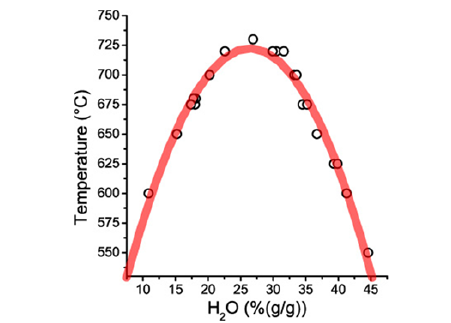
Figure 4:Distribution of fluorine vs. water concentration of some melt inclusions in pegmatite quartz from Volyn shows two separable but superimposed Gaussian distributions of fluorine versus the water content of the melt inclusions.
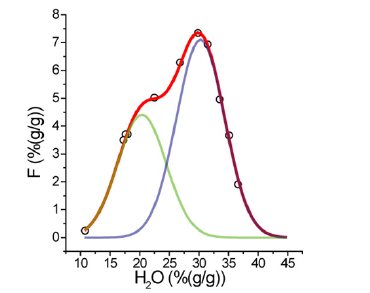
Figure 5:Salt-rich melt inclusion in pegmatite quartz from Volyn. L - Water-rich solution, V – vapor phase, XXX – alkali sulfates

Samples and Methods
The sample material for this study is from the second author, and the description is in Voznyak [10]. We used cold-seal pressure vessel homogenization experiments up to 750 °C and three kbar for the homogenization experiments on melt inclusions in quartz and topaz. This technique is detailed in Thomas et al. [11] and Thomas and Davidson (2015). For the study of daughter phases, diamond, graphite, as well as different hydrocarbons in the fluid and melt inclusions, we used a petrographic polarization microscope with a rotating stage, coupled with the RamMics R532 Raman spectrometer, working in the range 0-4000cm-1 using a 60mW single mode 532nm laser. More details are in [7].
Key Observations
Sensitized by the finding of nanodiamonds in the Ehrenfriedersdorf and Königshain granites and pegmatites [7], we also looked for nanodiamonds in minerals of the Volyn pegmatites and were successful. Tiny graphite inclusions in quartz are not rare. At complex graphite-nano-diamond inclusion, circumspection is necessary because of the possible contamination during preparation [12]. Therefore, we used only inclusions deep under the sample surface. Figure 6 shows such an aggregate of nano-diamond-bearing graphite. The discovery of nanodiamonds in pegmatite quartz from Volyn, together with the solvus curve and the extreme F enrichment around the solvus crest, show clearly that mantle components in the form of supercritical fluids participate in the pegmatite formation.
Figure 7 shows the Raman spectrum of nanodiamonds and graphite in Figure 6. Table 1 gives the Raman data for this sample’s diamond and graphite bands. The finding of fluid inclusions composed of organic material caused a further surprise because, the last time, an intense and controversial discussion on the 1.5-billion-year-old Volyn ‘biota’ of Ukraine [13,14] started. We found inclusions filled with liquid organic compounds (isoprene and other hydrocarbons), mainly with a small graphite or carbon ball (Figures 8 & 9). For the provisional identification of the hydrocarbons, we used the Raman spectroscopy and the Spectral Database for Organic Compounds [15]. It is clear to us that this is the first provisional identification method. More sophisticated studies are necessary. According to Hurai et al. [16], the Raman spectrum of Figure 10 is similar to saturated heptane C7H16H. Other inclusion types contain diisobutyl phthalate [C16H22O4]. Table 2 shows the measured and the SDBS database Raman bands. The differences in both spectra result mainly from the different laser wavelengths – 532 vs. 488nm (database). So, the organic liquid found in inclusion in pegmatite quartz from Volyn is similar to the diisobutyl phthalate. Other, more complex compounds like C7H11NO are present in inclusions too. Pavlishin & Dovgyi [1] described kerite as black fibrous aggregates (upto30x13x11cm large) by hydrothermal formation in the Volyn pegmatite. Kerite has a supramolecular structure and the composition C491H386O87S(N). That underlines the possibility of the appearance of complex organic compounds at higher temperatures (~600 to 700 °C).
Figure 6:Graphite (Gr) and nanodiamond (nD) in a melt inclusion in pegmatite quartz from Volyn. The inclusion is 40μm depth under the sample surface.

Figure 7:Raman spectrum of a graphite-nano diamond inclusion in pegmatite quartz from Volyn.
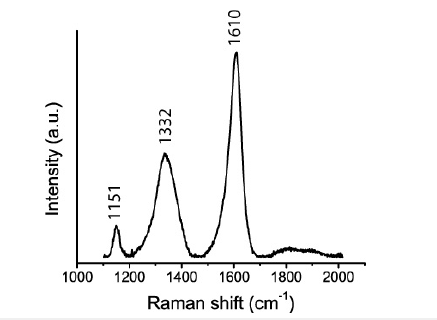
Figure 8:Fluid inclusion in pegmatite quartz from Volyn filled with isoprene [C5H8].
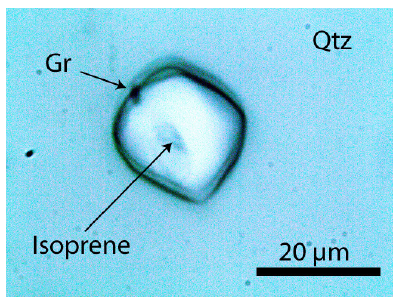
Figure 9:Fluid inclusion in pegmatite quartz from Volyn filled with dimethyl cyclohexane [C8H16] (I) at the rim, 2,3-xylenol [C8H10O] (II) in the center, and isoprene [C5H8] (III) in the tip (inserted small photomicrograph). Gr –graphite or carbon. Note the sharp meniscus between the hydrocarbons III and I and the more diffuse meniscus between I and II.
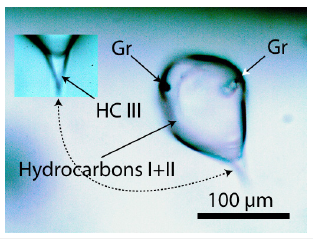
Figure 10:Raman spectrum of hydrocarbon II in Figure 9
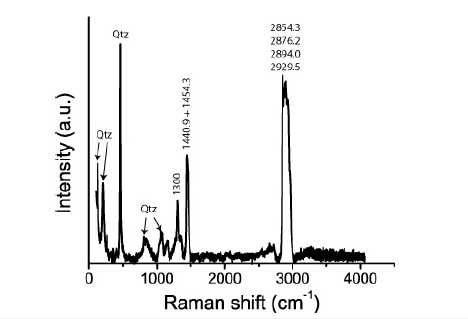
Table 1:Gaussian fit of the Raman spectrum of nanodiamond and graphitic carbon material. Chi2=122.3, and R2=0.99433. Width corresponds to the FWHM (full-width at half-maximum).

Table 2:Comparison of the Raman data between natural inclusion in pegmatite quartz from Volyn and the SDBS database reference No. 2842.

Interpretation
Interpreting the new inclusion type within quartz crystals from the Volyn pegmatites is difficult. As a rule, the unusual hydrocarbon-bearing inclusions are not near the sample surfaces. In addition, the inclusions are isolated in the quartz crystal and show never channels to the sample surfaces or other cleavage planes. Therefore, the interpretation of contamination introduced by the preparation (grinding, polishing, and cleaning using organic solvents) is doubtful. Conceivable is a catalytic formation of these hydrocarbons from graphite and/or methane (CH4). Graphite whiskers are present in topaz crystals (Figure 11), and in pegmatite quartz, graphite forms more isometric grains or is present as daughter phases in melt inclusions. Carbonic material in inclusions is another type. Figure 12 shows such inclusion composed of carbonic material and hydrocarbon II. The transition of the supercritical state into the critical and under-critical state is related to processes far from equilibrium. Some processes in this state are conventionally not feasible. An instructive example is the formation of moissanite whiskers in beryl at significantly lower temperatures and pressures [6,7], as is usually observed.
Figure 11:Graphite whisker (Gr) in topaz (Toz) of the Volyn pegmatite. The whisker is 300μm long and 14μm thick. The graphite main band is at 1576cm-1.
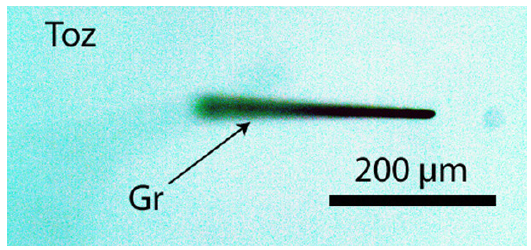
Figure 12:Liquid hydrocarbon-bearing (H.C.) inclusion in pegmatite quartz (Qtz) with black carbonaceous-like material (C).
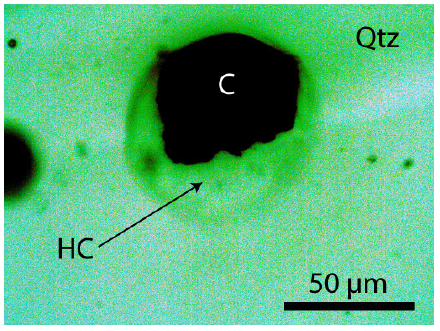
Discussion
The Volyn pegmatites contain typical fluid and melt inclusions. The general setup of the pegmatite formation can be derived from the melt inclusion data (Figure 3). Untypical are diamond-bearing inclusions (Figure 6), which demonstrate that at the formation of the gigantic pegmatites are mantle fluids (supercritical fluids) involved. Maybe such fluids are the cause of pegmatite formation. If the hydrocarbon inclusion is not contaminated, further studies must clarify the meaning and origin. The for and against discussion by Franz et al. [13] and Head et al. [14] has to consider the input or formation of natural hydrocarbons during the pegmatite formation. Maybe the large pegmatite chambers are places (natural chemical laboratories) where processes happen that are not possible under standard environmental conditions. Generally, the observations clearly show that in the case of chamber pegmatites from Volyn, fast crystallization is not the case. See the discussion by Popov [17]. The solvus curve and the chemical evolution inside the pegmatite chamber contradict such interpretations [18,19].
Acknowledgment
We thank the many people who contributed to decoding the pegmatite genesis and the function of supercritical fluids over the last 25 years. A special thanks go to James (Jim) D. Webster (1955- 2019), who initiated the intense work on evolved granites and pegmatites.
References
- Pavlishin, VI, Dovgyi SA (2007) Mineralogy of the volynian chamber pegmatites, Ukraine. Volodarsk-Volynsk, Mineralogical Almanac 12: 125.
- Thomas R, Davidson P, Rericha A, Recknagel U (2022) Discovery of stishovite in the prismatine-bearing granulite from Waldheim, Germany: A possible role of supercritical fluids of ultrahigh-pressure origin. Geosciences 12(5): 196.
- Lemmlein GG, Klija MO, Ostrovski IA (1962) On the conditions of mineral-formation in pegmatites according to the study of primary inclusions in Topaz. Doklady AN SSSR 142(1): 81-83.
- Thomas R (1994) Estimation of the viscosity and the water content of silicate melts from melt inclusion data. European Journal of Mineralogy 6(4): 511-535.
- Thomas R, Davidson P, Rericha A, Voznyak DK (2022) Water-rich melt inclusion as "frozen" samples of the supercritical state in granites and pegmatites reveal extreme element enrichment resulting under non-equilibrium conditions. Mineral Journ (Ukraine) 44(1): 3-15.
- Thomas R, Rericha A (2023) The function of supercritical fluids for the solvus formation and enrichment of critical elements. Geol. Earth Mar Sci 5(8): 1-4.
- Thomas R (2023) Growth of sic whiskers in beryl by a natural supercritical VLS process. Aspects in Mining & Mineral Sciences 11(4): 1292-1297.
- Roedder E (1984) Fluid inclusions. Reviews in mineralogy. Mineralogical Society of America 12: 646.
- Thomas R, Davidson P, Appel K (2019) The enhanced element enrichment in the supercritical states of granite-pegmatite systems. Acta Geochim 38: 335-349.
- Voznyak DK (2007) Microinclusions and reconstruction of conditions of endogenous mineral formation. Nauk. Dumka, Kyiv, U.A., 280 p.
- Thomas R, Davidson P, Rhede D, Leh M (2009) The miarolitic pegmatites from the Königshain: A contribution to understanding the genesis of pegmatites. Contri Mineral Petrol 157: 505-523.
- Thomas R (2023) The Königshainer Granit: Diamond inclusion in zircon. Geology Earth and Marine Sciences 5(6): 1-4.
- Franz, G, Lyckberg P, Khomenki V, Chournousenko V, Schulz HM, et al. (2022) Fossilization of Precambrian microfossils in the Volyn pegmatite Ukraine. Biogeosciences 19: 1795-1811.
- Head MJ, Riding JB, O Keefe JMK, Jeiter J, Gravendyck J (2023) Comment on Franz et al. 2023; A reinterpretation of the 1.5-billion-year-old Voly 'biota' of Ukraine, and discussion of the evolution of the eukaryotes. EGUsphere (Preprint repository) pp. 1-19.
- Author collective (1987) Spectral database for organic compounds SDBS, National Institute of Advanced Industrial Science and Technology (AIST), Japan.
- Hurai V, Huraiová M, Slobodník M, Thomas R (2015) Geofluids–developments in micro thermometry, spectroscopy, thermodynamics, and stable isotopes. Elsevier pp.489.
- Popov DV (2023) Do pegmatites crystallise fast? A perspective from petrologically-constrained isotopic dating. Geosciences 13(10): 297.
- Thomas R, Davidson P (2016) Origin of miarolitic pegmatites in the Königshain granite/Lusatia. Lithos 260(1): 225-241.
- Thomas R, Davidson P, Rericha A, Recknagel U (2023) Ultrahigh-pressure mineral inclusion in a crustal granite: Evidence for a novel transcrustal transport mechanism. Geosciences 13(4): 94.
© 2023 Rainer Thomas. This is an open access article distributed under the terms of the Creative Commons Attribution License , which permits unrestricted use, distribution, and build upon your work non-commercially.
 a Creative Commons Attribution 4.0 International License. Based on a work at www.crimsonpublishers.com.
Best viewed in
a Creative Commons Attribution 4.0 International License. Based on a work at www.crimsonpublishers.com.
Best viewed in 







.jpg)






























 Editorial Board Registrations
Editorial Board Registrations Submit your Article
Submit your Article Refer a Friend
Refer a Friend Advertise With Us
Advertise With Us
.jpg)






.jpg)














.bmp)
.jpg)
.png)
.jpg)










.jpg)






.png)

.png)



.png)






